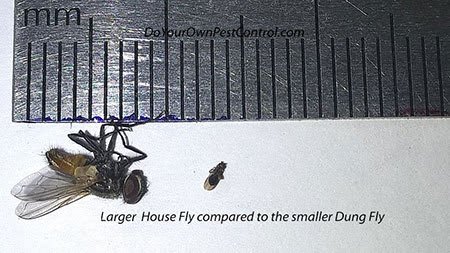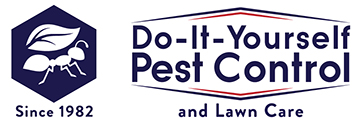
Sphaerocerid Fly Control
Sphaerocerid Identification and Inspection
 Sphaerocerid Fly image licensed under CC
Sphaerocerid Fly image licensed under CCSize: 1/8‐inch
Color: Black
On these flies, the first segment of the tarsi is enlarged compared to the other segments. The tarsi are the last five segments of the legs.
As is the case with most small flies, eliminating Sphaerocerid Flies requires finding and eliminating their breeding source. Finding these breeding sources is the difficult part but removing them is the only viable long-term solution.
- Look for decaying or fermenting organic matter. Check fruits and vegetables stored outside of refrigeration.
- Trash containers or dumpsters which are not cleaned regularly might be one such source. Inspect underneath and behind large appliances.
- Decaying organic matter may be trapped in cracks of kitchen equipment (where it meets the floor).
- Because many food handling establishments and food processing facilities use water hoses to wash down the floor consistently, floor debris may be caught in the small cracks and start to ferment. Use a knife to scrape and loosen the debris and look for their small worm-like larvae's presence.
- Inspect floor drains. It may be a breeding site, although it is more common to find drain flies, fruit flies, and phorid flies.
- Sphaerocerid, Drain, Phorid, and Fruit Flies are often found breeding in the super-thin layer or film of debris that naturally accumulates in pipes, traps, and drains.
- Floor and sink drains can then be treated with bio drain gels such as Invade Bio Drain Treatment: Invade Bio Drain Treatment Gel.
Sphaerocerid Biology and Habits
 The Sphaerocerid flies are also called "dung flies" because they may breed in animal manure.
The Sphaerocerid flies are also called "dung flies" because they may breed in animal manure.Sphaerocerid flies belong to a large family of flies known as Sphaeroceridae, which contains 241 species in North America.
These flies are prevalent in poultry houses breeding in chicken feces, but they can also become quite a nuisance in homes and businesses.
A few species feed in any decaying organic matter, meaning that they can be found in the same areas, such as Phorid flies and Fruit flies. The biology and habits are much the same as these other small flies.
Sphaerocerid Fly Control
- Finding and removing all breeding sources of Sphaerocerid flies is the first and best method of elimination.
- Floor drains need to regularly cleaned, not only for Sphaerocerid flies but the other small flies. Bleach and hot water are not adequate to remove breeding sources. Floor and sink drains can be treated with bio drain gels such as Invade Bio Drain Treatment: Invade Bio Drain Treatment Gel, as a component of Integrated Pest Management.
- If these flies are found breeding in crawlspaces or inside walls, the breeding source needs to be removed and dried thoroughly.
Understanding the different breeding sources for the flies will help you identify and manage the infestations.
Breeding Sources of Drain Flies, Fruit Flies, Phorid Flies, and Sphaerocerid Flies
Drain flies: Drain Flies breed in drains, sewers, septic tanks, and soil that has been contaminated with sewage.
Fruit flies: Fruit Flies can be spotted around fresh fruits/vegetables, rotting fruits and vegetables, drains, garbage, and damp organic materials.
Phorid Flies: Phorid Flies are found in sewage-contaminated soil, garbage, drains, human corpses, rotting vegetables, and fruit, garbage as well as damp organic materials.
Sphaerocerid Flies: These flies may be found in manure, damp organic material, drains, rotting fruits and vegetables, and garbage.
Sanitation Treatments
Use Invade Bio Products in the drains. Use of a drain cleaner such as Invade Bio Drain Treatment Gel will remove the organic debris, improving sanitation.
Invade Bio Foam is another type of Invade Bio product, particularly useful in commercial establishments. It is a concentrated bio liquid with the use of a foamer. Invade Bio Foam contains concentrated scum-eating, odor-eliminating microbes and a foaming agent. Use this a part of an integrated pest management tool. Use 1 oz per quart, 4 oz per gallon.Apply using a B&G VersaFoamer HH or sprayer to cracks, crevices, and drains where small flies breed. The foam and citrus combination will digest the organic debris present as part of pest management. Mix Ultra-concentrated Invade Bio Foam with water at a rate of 4 oz per gallon (1 oz per quart) and applied using Foam Sprayers.
Invade Hot Spot is a Microbial/Citrus Foam in an easy-to-use 16 oz aerosol. Hot Spot is an aerosol can that contains the same premium microbes and ingredients as InVade Bio Foam. The 360-degree valve allows for foam dispensing in any orientation to hit hard-to-reach areas easily.
Sanitation Treatments
Prevent Sphaerocerid Flies
Finding and removing all of these Sphaerocerid flies' breeding sources is the first and best method of elimination.
Regularly clean floor drains. Pouring bleach and hot water down the drain is not adequate.
The film of organic matter which lines the drain is where the larvae live.
This film must be removed to kill or remove the larvae. Remove this organic film by using a brush and a mild bleach solution.
Water can then be used to flush the drain thoroughly. Cleaning infested drains initially is quite often a messy job, but future cleanings will be much easier. An alternative is to use Invade Bio Drain. It is a beneficial bacteria that begins to digest the film of organic matter when poured down the drain. When this organic film is gone, the flies have nowhere to lay their eggs. If these flies are found breeding in crawlspaces or inside walls, the breeding source needs to be removed and dried thoroughly.








